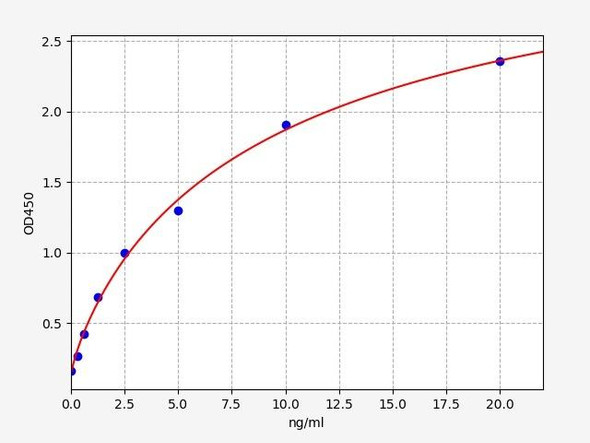Rat Protein Kinase C Epsilon / PKCe ELISA Kit
- SKU:
- RTFI01068
- Product Type:
- ELISA Kit
- Size:
- 96 Assays
- Uniprot:
- P09216
- Sensitivity:
- 0.094ng/ml
- Range:
- 0.156-10ng/ml
- ELISA Type:
- Sandwich ELISA, Double Antibody
- Synonyms:
- PKCE, PRKCE, MGC125656, nPKC-epsilon, PKCE, PKCEMGC125657, PRKCE, protein kinase C epsilon type, protein kinase C, epsilon
- Reactivity:
- Rat
Description
| Product Name: | Rat PKCE (Protein Kinase C Epsilon) ELISA Kit |
| Product Code: | RTFI01068 |
| Size: | 96 Assays |
| Target: | Rat PKCE |
| Alias: | PKCE, PRKCE, MGC125656, nPKC-epsilon, PKCE, PKCEMGC125657, PRKCE, protein kinase C epsilon type, protein kinase C, epsilon |
| Reactivity: | Rat |
| Detection Method: | Sandwich ELISA, Double Antibody |
| Sensitivity: | 0.094ng/ml |
| Range: | 0.156-10ng/ml |
| Storage: | 4°C for 6 months |
| Note: | For Research Use Only |
| Recovery: | Matrices listed below were spiked with certain level of Rat PKCE and the recovery rates were calculated by comparing the measured value to the expected amount of Rat PKCE in samples. | ||||||||||||||||
| |||||||||||||||||
| Linearity: | The linearity of the kit was assayed by testing samples spiked with appropriate concentration of Rat PKCE and their serial dilutions. The results were demonstrated by the percentage of calculated concentration to the expected. | ||||||||||||||||
| |||||||||||||||||
| Intra-Assay: | CV <8% | ||||||||||||||||
| Inter-Assay: | CV <10% |
| Uniprot: | P09216 |
| UniProt Protein Function: | PKCE: an AGC kinase of the PKC family. Calcium-independent, phospholipid-dependent. Activated by inflammatory mediators and involved in nociceptive functions. PKC-epsilon null mice display decreased hypoxic pulmonary vasoconstriction. |
| UniProt Protein Details: | Protein type:Protein kinase, AGC; Kinase, protein; Protein kinase, Ser/Thr (non-receptor); EC 2.7.11.13; AGC group; PKC family; Eta subfamily Chromosomal Location of Human Ortholog: 2p21 Cellular Component: Golgi apparatus; cytoskeleton; mitochondrion; perinuclear region of cytoplasm; endoplasmic reticulum; cytoplasm; plasma membrane; cytosol; nucleus Molecular Function:actin monomer binding; calcium-independent protein kinase C activity; protein serine/threonine kinase activity; signal transducer activity; protein binding; protein kinase C activity; enzyme binding; metal ion binding; enzyme activator activity; ethanol binding; receptor activator activity; ATP binding Biological Process: nerve growth factor receptor signaling pathway; apoptosis; response to morphine; positive regulation of lipid catabolic process; signal transduction; protein amino acid phosphorylation; positive regulation of MAPKKK cascade; lipopolysaccharide-mediated signaling pathway; cell adhesion; regulation of peptidyl-tyrosine phosphorylation; epidermal growth factor receptor signaling pathway; positive regulation of cytokinesis; platelet activation; fibroblast growth factor receptor signaling pathway; positive regulation of I-kappaB kinase/NF-kappaB cascade; positive regulation of synaptic transmission, GABAergic; positive regulation of insulin secretion; cell cycle; peptidyl-serine phosphorylation; positive regulation of actin filament polymerization; cell division; phospholipase C activation; release of sequestered calcium ion into cytosol; macrophage activation during immune response; innate immune response; blood coagulation |
| NCBI Summary: | Protein kinase C (PKC) is a family of serine- and threonine-specific protein kinases that can be activated by calcium and the second messenger diacylglycerol. PKC family members phosphorylate a wide variety of protein targets and are known to be involved in diverse cellular signaling pathways. PKC family members also serve as major receptors for phorbol esters, a class of tumor promoters. Each member of the PKC family has a specific expression profile and is believed to play a distinct role in cells. The protein encoded by this gene is one of the PKC family members. This kinase has been shown to be involved in many different cellular functions, such as neuron channel activation, apoptosis, cardioprotection from ischemia, heat shock response, as well as insulin exocytosis. Knockout studies in mice suggest that this kinase is important for lipopolysaccharide (LPS)-mediated signaling in activated macrophages and may also play a role in controlling anxiety-like behavior. [provided by RefSeq, Jul 2008] |
| UniProt Code: | P09216 |
| NCBI GenInfo Identifier: | 4885563 |
| NCBI Gene ID: | 5581 |
| NCBI Accession: | NP_005391.1 |
| UniProt Secondary Accession: | P09216,P16054, P09216, |
| UniProt Related Accession: | Q02156 |
| Molecular Weight: | |
| NCBI Full Name: | protein kinase C epsilon type |
| NCBI Synonym Full Names: | protein kinase C epsilon |
| NCBI Official Symbol: | PRKCE |
| NCBI Official Synonym Symbols: | PKCE; nPKC-epsilon |
| NCBI Protein Information: | protein kinase C epsilon type |
| UniProt Protein Name: | Protein kinase C epsilon type |
| UniProt Synonym Protein Names: | nPKC-epsilon |
| UniProt Gene Name: | PRKCE |
| UniProt Entry Name: | KPCE_HUMAN |
| Step | Procedure |
| 1. | Set standard, test sample and control (zero) wells on the pre-coated plate respectively, and then, record their positions. It is recommended to measure each standard and sample in duplicate. Wash plate 2 times before adding standard, sample and control (zero) wells! |
| 2. | Aliquot 0.1ml standard solutions into the standard wells. |
| 3. | Add 0.1 ml of Sample / Standard dilution buffer into the control (zero) well. |
| 4. | Add 0.1 ml of properly diluted sample ( Human serum, plasma, tissue homogenates and other biological fluids.) into test sample wells. |
| 5. | Seal the plate with a cover and incubate at 37°C for 90 min. |
| 6. | Remove the cover and discard the plate content, clap the plate on the absorbent filter papers or other absorbent material. Do NOT let the wells completely dry at any time. Wash plate X2. |
| 7. | Add 0.1 ml of Biotin- detection antibody working solution into the above wells (standard, test sample & zero wells). Add the solution at the bottom of each well without touching the side wall. |
| 8. | Seal the plate with a cover and incubate at 37°C for 60 min. |
| 9. | Remove the cover, and wash plate 3 times with Wash buffer. Let wash buffer rest in wells for 1 min between each wash. |
| 10. | Add 0.1 ml of SABC working solution into each well, cover the plate and incubate at 37°C for 30 min. |
| 11. | Remove the cover and wash plate 5 times with Wash buffer, and each time let the wash buffer stay in the wells for 1-2 min. |
| 12. | Add 90 µL of TMB substrate into each well, cover the plate and incubate at 37°C in dark within 10-20 min. (Note: This incubation time is for reference use only, the optimal time should be determined by end user.) And the shades of blue can be seen in the first 3-4 wells (with most concentrated standard solutions), the other wells show no obvious color. |
| 13. | Add 50 µL of Stop solution into each well and mix thoroughly. The color changes into yellow immediately. |
| 14. | Read the O.D. absorbance at 450 nm in a microplate reader immediately after adding the stop solution. |
When carrying out an ELISA assay it is important to prepare your samples in order to achieve the best possible results. Below we have a list of procedures for the preparation of samples for different sample types.
| Sample Type | Protocol |
| Serum: | If using serum separator tubes, allow samples to clot for 30 minutes at room temperature. Centrifuge for 10 minutes at 1,000x g. Collect the serum fraction and assay promptly or aliquot and store the samples at -80°C. Avoid multiple freeze-thaw cycles. If serum separator tubes are not being used, allow samples to clotovernight at 2-8°C. Centrifuge for 10 minutes at 1,000x g. Removeserum and assay promptly or aliquot and store the samples at-80°C. Avoid multiple freeze-thaw cycles. |
| Plasma: | Collect plasma using EDTA or heparin as an anti-coagulant. Centrifuge samples at 4°C for 15 mins at 1000 — g within 30 mins of collection. Collect the plasma fraction and assay promptly or aliquot and store the samples at -80°C. Avoid multiple freeze-thaw cycles.Note: Over haemolysed samples are not suitable for use with this kit. |
| Urine & Cerebrospinal Fluid: | Collect the urine (mid-stream) in a sterile container, centrifuge for 20 mins at 2000-3000 rpm. Remove supernatant and assay immediately. If any precipitation is detected, repeat the centrifugation step. A similar protocol can be used for cerebrospinal fluid. |
| Cell Culture Supernatant: | Collect the cell culture media by pipette, followed by centrifugation at 4°C for 20 mins at 1500 rpm. Collect the clear supernatant and assay immediately. |
| Cell Lysates: | Solubilize cells in lysis buffer and allow to sit on ice for 30 minutes. Centrifuge tubes at 14,000 x g for 5 minutes to remove insoluble material. Aliquot the supernatant into a new tube and discard the remaining whole cell extract. Quantify total protein concentration using a total protein assay. Assay immediately or aliquot and store at ≤ -20°C. |
| Tissue Homogenates: | The preparation of tissue homogenates will vary depending upon tissue type. Rinse tissue with 1X PBS to remove excess blood & homogenizein 20ml of 1X PBS (including protease inhibitors) and store overnight at ≤ -20°C. Two freeze-thaw cycles are required to break the cell membranes. To further disrupt the cell membranes you can sonicate the samples. Centrifuge homogenates for 5 mins at 5000xg. Remove the supernatant and assay immediately or aliquot and store at -20°C or-80°C. |
| Tissue Lysates: | Rinse tissue with PBS, cut into 1-2 mm pieces, and homogenize with a tissue homogenizer in PBS. Add an equal volume of RIPA buffer containing protease inhibitors and lyse tissues at room temperature for 30 minutes with gentle agitation. Centrifuge to remove debris. Quantify total protein concentration using a total protein assay. Assay immediately or aliquot and store at ≤ -20 °C. |
| Breast Milk: | Collect milk samples and centrifuge at 10,000 x g for 60 min at 4°C. Aliquot the supernatant and assay. For long term use, store samples at -80°C. Minimize freeze/thaw cycles. |










